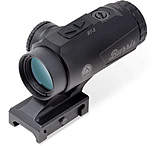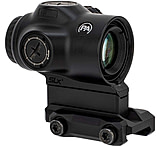Prismatic sights utilize a prism to focus light as it passes through the sight, making them a distinct type of red dot sight. These sights combine the advantages of traditional variable-powered scopes and red dot sights. This guide aims to elucidate the benefits of prismatic sights and compare them to both red dots and variable rifle scopes.![]()
Prismatic Sights vs. Variable Rifle Scopes
Traditional variable-powered scopes rely on multiple lenses to concentrate light for functionality. In contrast, prismatic sights, equipped
with two prisms offer a more compact design than variable power scopes. However, unlike variable power scopes, prismatic sights possess a fixed magnification that cannot be adjusted. Both prismatic sights and variable power scopes can feature intricate reticles, whether illuminated or not. These reticles encompass Bullet Drop Compensating reticles, MOA and Mil Radian reticles with various sub-tensions, and numerous application-specific options. Additionally, prismatic sights come with an integrated mount, eliminating the need for a separate mount purchase, as required for riflescopes.
Prismatic Sights vs. Red Dot Sights
Red dot sights and prismatic sights share the trait of compactness and lack adjustable magnification. However, red dot sights are non-magnified, while prismatic sights possess a fixed magnification capability. Red dot sights produce reticles using different methods. A reflex sight projects a red dot onto a reflective lens, visible to the user looking through the sight. When the user looks through the sight, the reticle becomes visible. On the other hand, prismatic sights employ an etched reticle, meaning the reticle is etched into the glass of the sight. The advantage of an etched reticle is that it remains visible even without batteries. Most prismatic sights offer an illuminated reticle that can light up the etched reticle when batteries are used. However, non-prismatic red dot sights require batteries for operation. Prismatic sights can also house a complex reticle.
Certain holographic sights incorporate BDC or circle dot reticles with BDC capabilities, while red dots typically employ simpler reticles.
Another advantage of prismatic sights over red dot sights is the improved reticle clarity they offer to users with astigmatism. Astigmatism refers to an irregularity in the curvature of the eye, which impairs the eye's ability to focus light properly. This common issue often causes the reticle of a red dot sight to appear blurry. Conversely, prismatic sights with their etched reticles are easier to focus on since they are more than just a point of light.
Are Prism Sights Worth It?
Prismatic sights are compact, fixed-power optics available in various magnifications, outshining traditional variable-powered scopes in terms of compactness. They employ an etched reticle, allowing their use without batteries or a power source, and enabling the incorporation of complex reticles like BDC options. The etched reticle also benefits users with astigmatism, providing a clear reticle compared to red dot sights such as reflex or holographic sights. Prismatic sights serve as an excellent choice for new gun owners, offering a favorable blend of features and price range between red dot sights and variable power rifle scopes.



